
 N
N)
or press the Start New Solution link on the welcome screen.

Brian Long Consultancy & Training Services
Ltd.
February 2012
Accompanying source files available through this
download link
For our first foray into iPhone application development, tradition dictates we do
a Hello World program. In MonoDevelop choose File, New, Solution… (or press
)
or press the Start New Solution link on the welcome screen.![]()
![]() N
N
Here you can see the various MonoTouch project templates available. We’ll start off with a Single View Application, since a Hello World will just have a single screen.

This creates a solution containing a single project made up of various
files. As with Visual Studio a solution is a means of managing potentially multiple
projects. The file opened up by default after creating the project is
AppDelegate.cs containing the AppDelegate
class, which represents a delegate for the underlying CocoaTouch Application object and
can respond to Application events, such as the FinishedLaunching event
that triggers when the app has loaded up and which typically contains initialization
code.

Info.plist is a property list file used to set various properties of interest to iOS. We’ll ignore this for now (we'll come back to it later).
One of the other files is Main.cs; this contains the simple
Application class whose class method Main is
the application’s entry point.
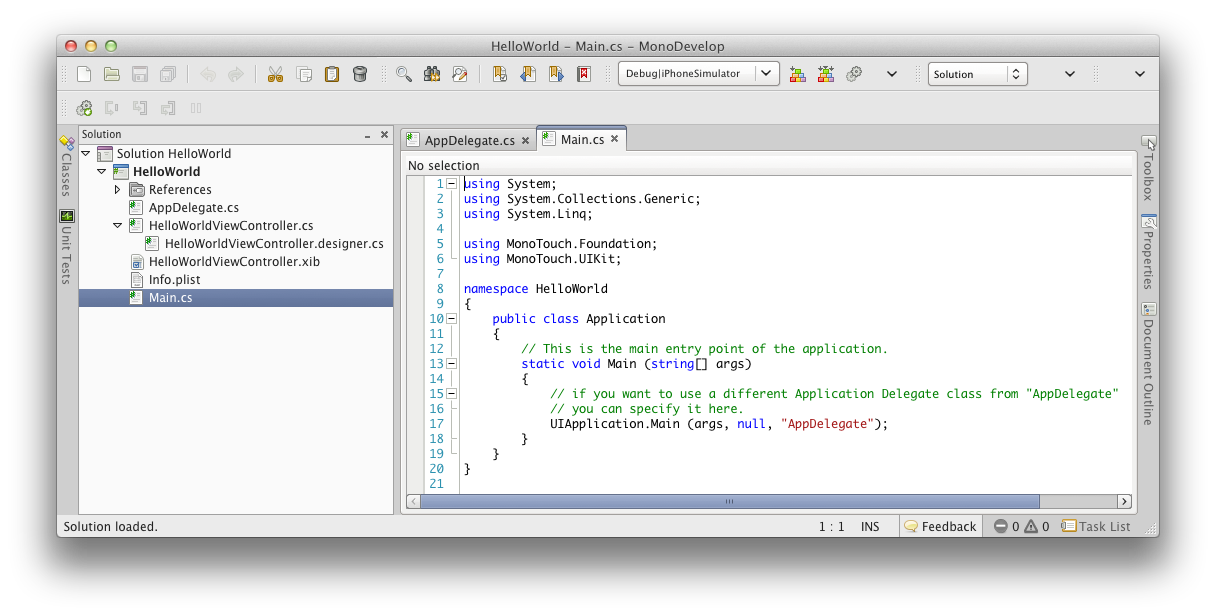
The more interesting file, however, is HelloWorldViewController.cs. We could
add the functionality of a simple single-screen app into the app delegate class,
but purists might suggest that class is best left to act as a delegate for the CocoaTouch
Application object. Typical applications are more likely to use one
or more view controllers (UIViewController or a descendant)
as delegates for views on the various windows in the application.
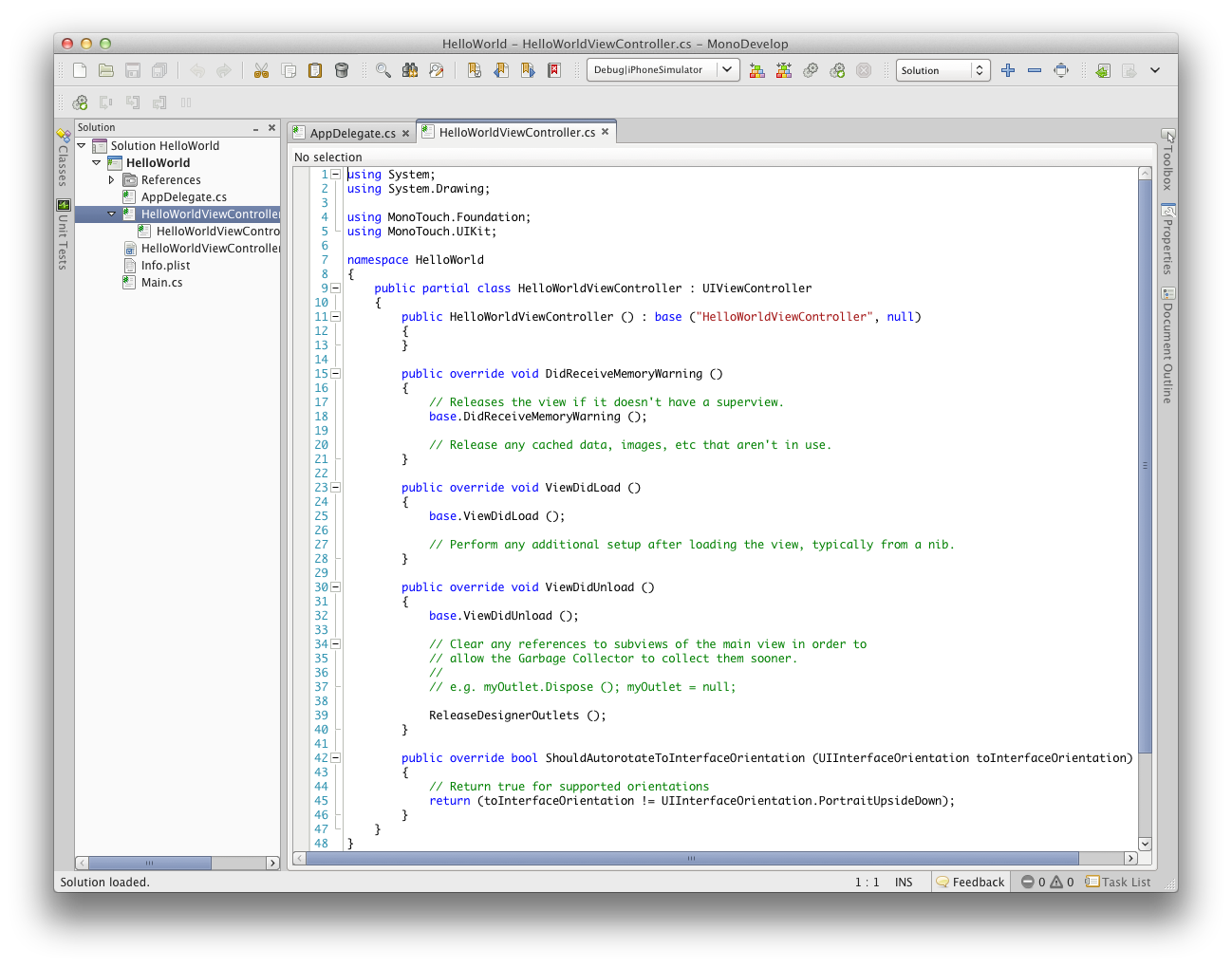
CocoaTouch operates with an MVC model and this delegate model crops up regularly, for example with event handlers for UI controls.
Talking of UI controls, we need to set up a UI - a view for the view controller to control. The HelloWorldViewController.xib file represents the UI; when double-clicked it will be opened by Xcode in its Interface Builder pane. Historically, Interface Builder was a separate application but as of Xcode 4 has been integrated into the Xcode environment. You’ll be spending some time with Xcode's Interface Builder pane as you build screens for MonoTouch projects.
Note: Originally, Apple UI files were binary and used a .nib extension. When building iOS applications the UI files are XML and use the .xib extension. It is common for OS X and iOS developers to refer to both .xib and .nib files simply as nib files.
Just before looking at Interface Builder I’ll point out the other source file in the project. HelloWorldViewController.designer.cs is an auto-generated file that contains code necessary to access parts of the UI, referred to as the .xib’s code-behind file. We’ll take a look at it again presently.
Interface Builder is the UI-designing part of Apple’s Xcode development environment and is where we build the UI design part of the iOS application. Which solution/project template you start with dictates the size of the window you get to design, as the resolutions are different. iPhone and iPod Touch are 320x480 whereas iPad is 1024x768.
Note: iPhone 4 has a higher resolution screen than iPhone 3 at 640x960. That is an increase in pixel resolution but, when measured in points, all iPhones offer a 320x480 resolution. This means you only need to design the UI once and it works on all iPhones.
When your .xib file opens in Xcode you are presented with the bare UI in Xcode's
Interface Builder pane. On the left side of the window is the Project Navigator,
a hierarchical view of files that constitute the Xcode project you are working on.
The Navigator pane can show various Navigator views and defaults to showing the
Project Navigator. If you want to retrieve the Project Navigator at any time you
can choose View, Navigators, Show Project Navigator (or press
).![]() 1
1
Note: The Navigator can be toggled off and on using the first of
the three View toolbuttons on Xcode's toolbar. It can also be toggled with
,
which alternates between being the shortcut for View, Navigators, Hide Navigator and
View, Navigators, Show Navigator.![]() 0
0
On the left edge of the Interface Builder is the Dock, where the View can be seen selected. There are other items you can select in the Dock - File's Owner or First Responder but the View is what we'll be focusing on here.
As you add objects to the View you can use the Document Outline to select them (in cases where they are obscured by other objects). The Document Outline appears when you expand the Dock by using the little triangle button at the bottom (or by choosing Editor, Show Document Outline) and can be collapsed again using the same button (or by choosing Editor, Hide Document Outline). The Document Outline was a separate window (the Document window) when Interface Builder was separate from Xcode. You can see the Document Outline in one of the screenshots further down.
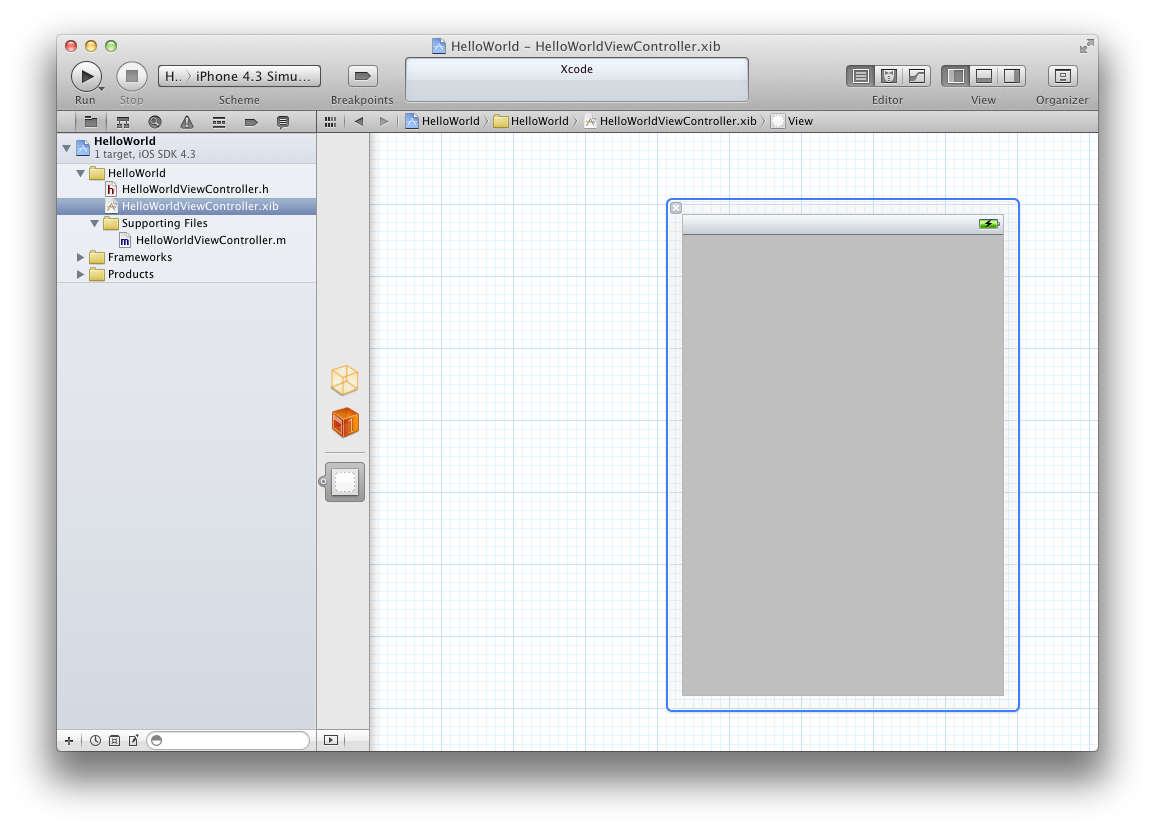
Note: the view designer is sized appropriately for your iOS target device (in this case the window is 320x480). If you look carefully at the screenshot, you’ll see that at the top of the window is a simplistic representation of the iPhone’s status bar. This window is essentially a form designer and will reflect our UI as we build it up by adding controls and views.
To edit your view UI you will need to see the available objects you can add. You
can do this by displaying the Object Library in the Utilies window. Either choose
View, Utilities, Show Object Library or press ^ (that’s
![]()
![]() 3
3Ctrl-Option-Command-3 or Ctrl-Alt-Apple-3 or Ctrl-Alt-Cmd-3
depending on what's written on your keyboard). There is a Search box at the bottom
of the window that filters the potentially long lists shown by default.
Then to edit an object placed on the view (or the view itself) you'll need the Xcode
equivalent of an Object Inspector or Properties Inspector, which is called the Attributes
Inspector and is also displayed in the Utilities window. Either choose View, Utilities,
Show Attributes Inspector or press
.
There are other Inspectors, such as the Connections Inspector, which we'll
bump into later.![]()
![]() 4
4
The UI of this starting app will require two Labels (UILabel controls),
a Round Rect Button (UIButton) and a Text Field (UITextField).
To find these input controls in the Object Library window use the drop-down control
to show only Controls (as opposed to the full library of CocoaTouch and
custom objects, which is selected by default). This cuts down the list considerably
and so you should be able to find the controls readily – they are all adjacent in
the list. Again, you can also use the search box to search for the class name or
the description (though that resets the drop down filter to show the whole library
once more).
Note: When you select an object in the Object Library you get a balloon help window to give you information about it.
Note: You can toggle the Utilities window on and off using the
last of the three View toolbuttons on Xcode's toolbar. It can also be toggled
with
,
which alternates between being the shortcut for View, Utilities, Hide Utilities and
View, Utilities, Show Utilities.![]()
![]() 0
0
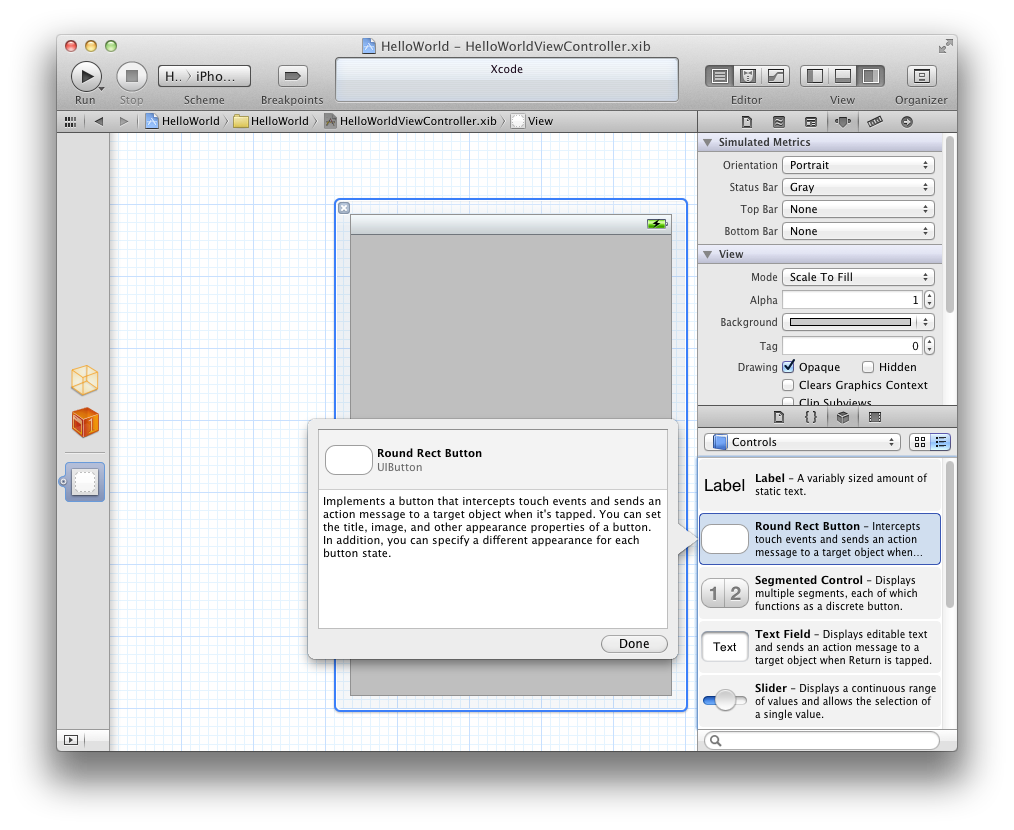
Drag the controls to the view and arrange them as below. You can edit the text in
all these controls either by double-clicking the control, or using the Text or Title
attributes, as appropriate, in the Attributes Inspector (![]()
![]() 4
4
If you prefer dark backgrounds, you can set the text color for the labels and the background color of the window itself. The window attributes also let you set the color of the iPhone’s status bar.
Note: The Status Bar setting is described in Interface Builder as a Simulated Metric, so shows you what it might look like, but won’t have an effect at runtime. To finish the job we need to do it in code, and we will.
The text field will automatically pop up a keyboard when tapped (we shall see later that, whilst the keyboard will automatically pop up, it is down to the programmer to dismiss it) and there are various attributes we can configure in the Attributes Inspector. In this case set it to capitalize words and set the Return Key attribute to Done, which changes the normal Return button on the keyboard to be a Done button instead.

That’s the UI designed, but before leaving Xcode we need to cater for the programming that comes next.
The code will need to read from the text field and write to the bottom label (and also, just to prove we can, we’ll be writing to the button as well). In order to access the controls we need to define the variables that will refer to them, which are not created by default. These variables are called outlets and are defined by dragging from the control to an Objective-C header file. Yes, we need to work with an Objective-C header file while using Interface Builder, and when we're done, any changes made to the header file will be reflected to the C# code in our MonoTouch project.
To show the header file for the selected View and then add in outlets we use the
Assistant Editor. The middle of the three Editor toolbuttons displays this, as does
selecting View, Assistant Editor, Show Assistant Editor (or pressing
,
which is ![]()
![]()
![]()
Option-Command-Enter or Alt-Apple-Enter or
Alt-Cmd-Enter depending on what's written on your keyboard's keys).
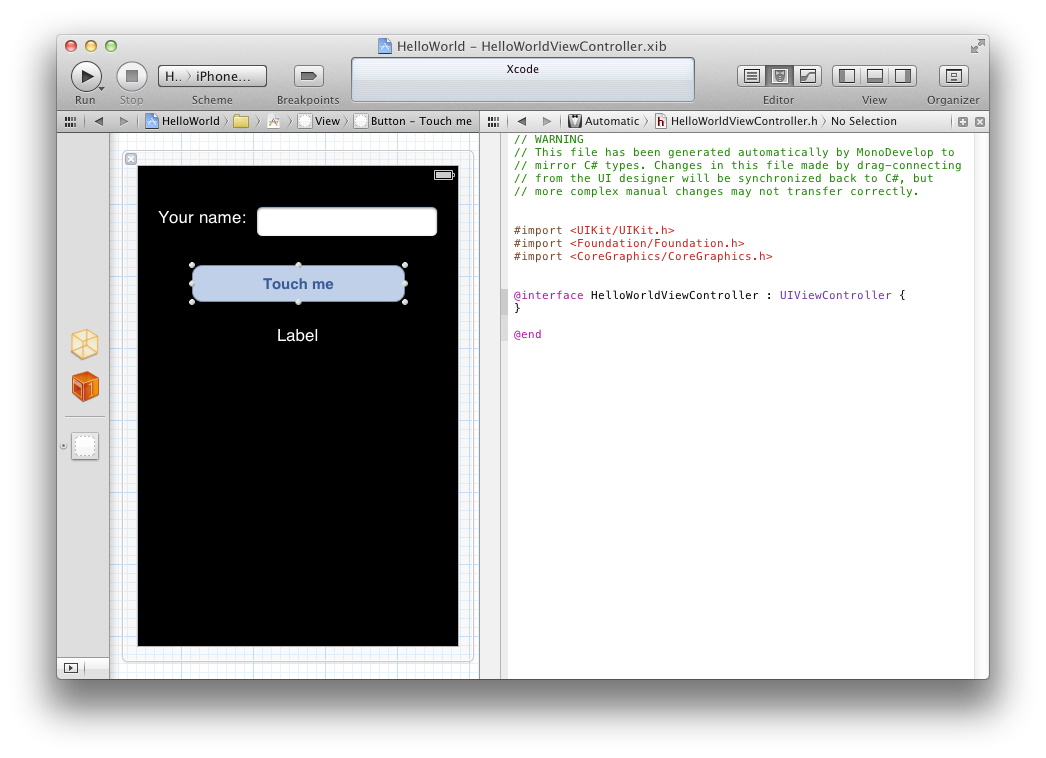
To add an outlet for a control you Ctrl+drag from it (or from its
representation in the Document Outline) into the header file and
ensure an insertion indicator appears telling you that you can successfully drop
it there.
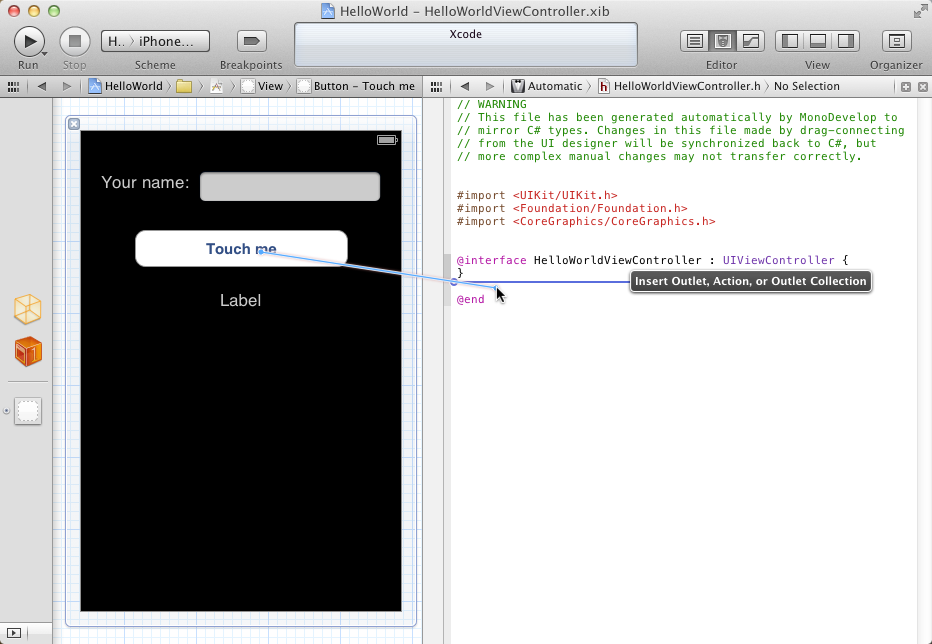
When you release the mouse button you can choose whether this is an outlet or action (see later), verify its type and give it a name.
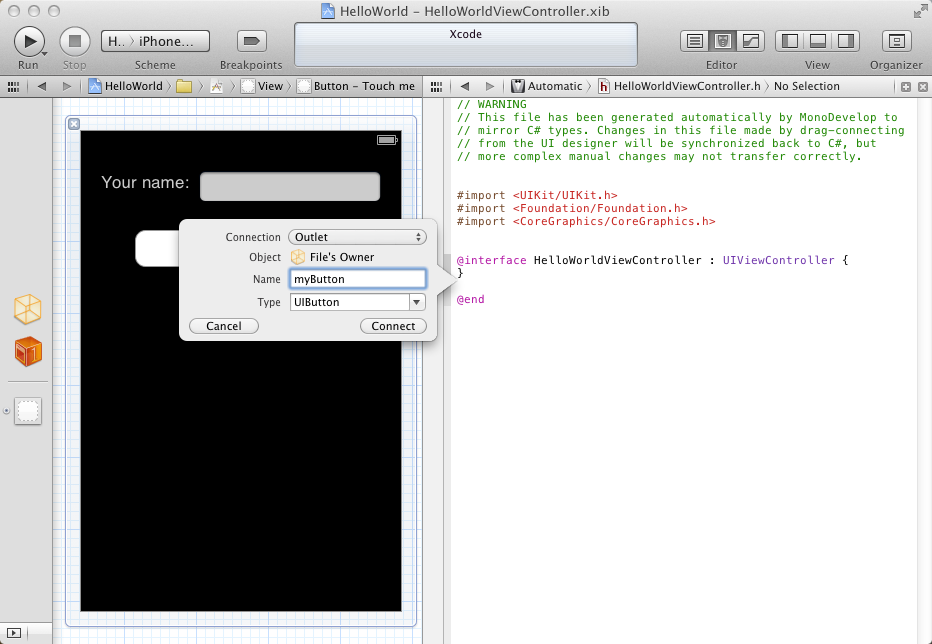
Having given it a name and pressed Connect the outlet is added to the header file. Here is the file after all the required outlets have been added:

The CocoaTouch controls available in Interface Builder have various events that can be responded to, as you’d probably expect. However when using MonoTouch we have a choice of two ways to set up the event handler. One way requires an outlet to be set up in Interface Builder and then uses normal .NET-style events in the source code. The second way matches the traditional Cocoa programming model and revolves around actions and we’ll look at this approach just now.
An action represents a method that gets implemented in your class but is connected
to a control’s event in Interface Builder. You set up an action in Interface Builder
in a similar way to defining an outlet - Ctrl+drag from the control whose event
should be connected to the action and drop in the header file in the Assistant
Editor. This pops up the action/outlet editor so you should choose Action as the
connection type and enter the action name.
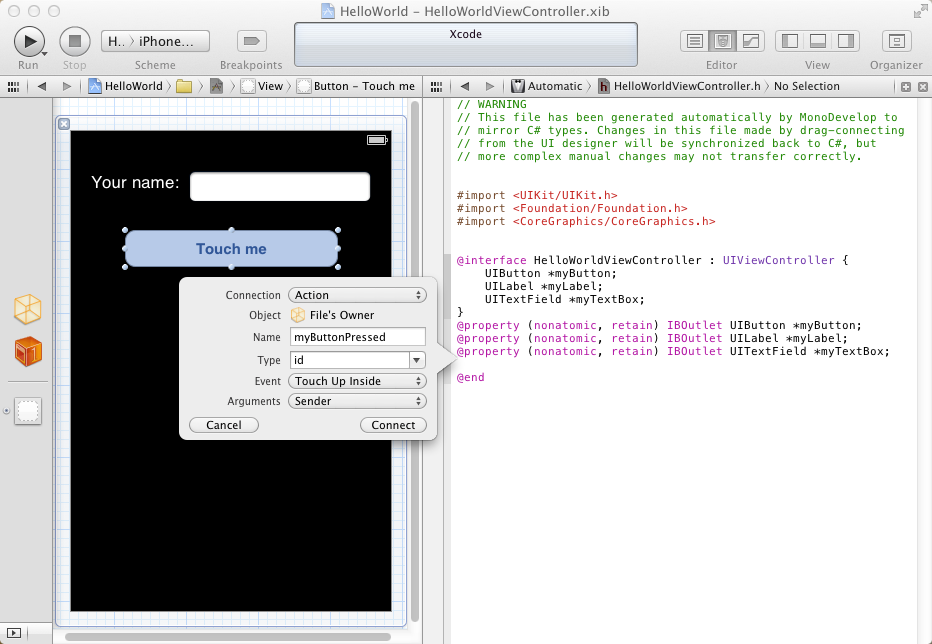
Now save the Xcode project (![]() S
S
Go back to the top of this page
Go back to start of this article